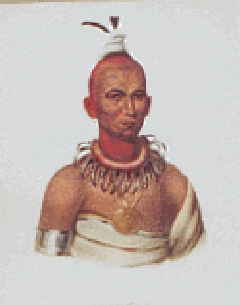
Choncape
(Big Kansas), an Oto chief
[Info
from Biographical Sketches and Anecdotes...
By Thomas L. McKenney and James Hall]
Choncape is part of the famous McKenney-Hall
portfolio:
Under the patronage of Thomas L. McKenney, Commissioner of Indian
Trade, artist Charles Bird King produced a 143 portraits of Indian
dignitaries, visiting Washington, DC, over a 20-year period. In Thomas
McKenney & James Hall History of the Indian Tribes of North
America., Philadelphia: 1837-1844, Folio 120 - 121 hand colored
lithographs, McKenney and Hall's impressive portfolio of Indian
portraits documents an important part of American History--great
leaders of Indian nations which have disappeared since the
mid-nineteenth century. As head of the United States Bureau of Indian
Affairs for many years, McKenney championed the Indian cause.
Throughout his tenure he worked to preserve something of their culture,
an integral a part of American history. His legacy was a gallery or
portraits of the great chiefs by artists such as James Otto Lewis,
Charles Bird King, and George Cooke. McKenney took office in 1816.
Shortly thereafter he planned an archive to house Indian memorabilia.
In the winter of 1821-22 a large delegation of Indians comprising
Pawnee, Sauk, Fox, Menominee, Miami, Sioux, and Chippewa came to
Washington to see President James Monroe. In the first quarter of the
19th century, as the Indians traveled to Washington DC to discuss their
plight, the destruction of their lands and loss of their people, they
would appeal to Thomas McKenney, who at the time was chief of the
Bureau of Indian Affairs. McKenney commissioned grand portraits to be
produced, creating the first view of the indigenous people of North
America. The original oil paintings, from which hand colored
lithographs were produced, by Charles Bird King, were destroyed by fire
at the Smithsonian c. 1870. These lithographs are now the only visual
records of this great work. McKenney and Hall's hand colored
lithographs remain some of the most beautiful records of Native
Americans ever produced in the nineteenth century. Oil paintings were
done as formal studio portraits of tribal leaders and members of their
parties who came to Washington to sign treaties.
His expenditures on
the portrait gallery were not looked upon favorably in Washington, and
he eventually lost his appointment. His next endeavor was to have the
oil portraits published as a series of hand colored lithographs. Most
of the paintings were lost in a tragic fire at the Smithsonian in 1865,
so these lithographs have become an important historic record of Native
American people. McKenney took advantage of the opportunity to record
their likenesses. He commissioned Lewis and King. Over the years he
accumulated an impressive gallery of Indian portraiture. In 1830,
President Andrew Jackson dismissed McKenney, who then decided to
publish the portraits, McKenney's folio was completed six years later;
the first edition plates were first published in 1832. The folio was a
collaborative effort. Jams Hall's text was based on information
McKenney supplied. The obstacles to the successful publication were
considerable. McKenney battled poverty, politics, and printers to
achieve his goal. Originally issued in a large folio size, McKenney had
the images redrawn to a more practical and affordable octavo size.
Though he knew he was preserving a chapter in history, he did not know
that no record would remain. In 1865 a fire at the Smithsonian
destroyed almost all the original paintings from which the lithographs
were drawn.
 Return to Indigenous Peoples' Literature
Return to Indigenous Peoples' Literature
Compiled by: Glenn Welker
ghwelker@gmx.com
Copyright @ 1993-2016
This site has been accessed 10,000,000 times since February 8, 1996.


![]() Return to Indigenous Peoples' Literature
Return to Indigenous Peoples' Literature